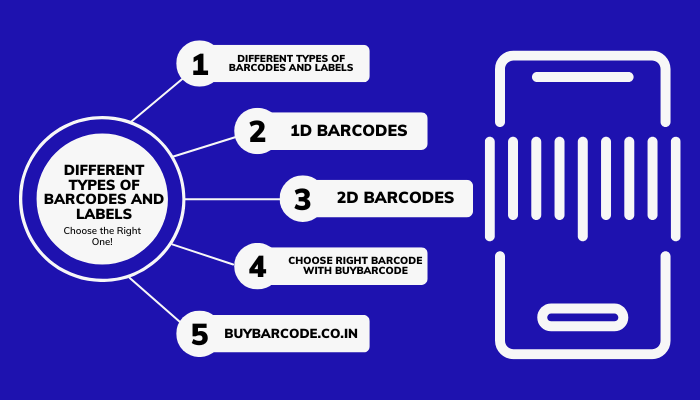
With the right tool at hand, one is empowered to make so much of a difference in smoothening the workings of a shop in today’s

A lot of business owners don’t know that there are different types of barcodes available for diverse products. The choice majorly depends on factors like size of the organization, printing costs, software compatibility, and barcode specifications. Since barcodes in 2024 are available in a wide range of options, it can be difficult to conclude which one will be the best fit for your business. And the most important question is which barcode will give more value to the business and enhance the efficiency of your enterprise.
That’s why BuyBarCode – a leading provider of barcodes in India – decided to dive deeper into the different types of barcodes ( 1D or 2D ) to help you find the right product labeling solution for your products. Let’s start!
Usually, barcodes are divided into two major categories which are:
These are divided according to their usage and durability so that businesses can make wise decisions depending on their needs.
Below are some of the common types of 1D and 2D barcodes and labels.
Originally created for grocery stores, these types of barcodes are usually found on retail products for quick receipt printing and inventory tracking. UPC barcodes are generally used to label and scan consumer goods when they are ready for sale. UPC- A consists of twelve numerical digits, whereas UPC-E is a smaller variation with only six numerical digits.
To make the checkout procedure effective, UPC barcodes help in smoothly running the inventory tracking process to stores and warehouses.
The International Article Number (also known as European Article Number or EAN) is a standard describing a barcode symbology and numbering system used in global trade to identify a specific retail product type, in a specific packaging configuration, from a specific manufacturer.
These codes are very similar to UPC codes but the main difference lies in their geographical application.
Flexibility and durability are the two greatest advantages of these codes. They are also easy for 1D scanners to read, making the scanning process fast and seamless.
EAN-13 is used to store large amounts of data in a small area – while EAN-8 codes are for very small products or assets.
A self-checking barcode also known as Alpha39 or (or Code 3 of 9) is a standard alphanumeric code that contains 43 characters. These codes are used for labeling goods of many industries and are commonly found in the automotive industry and the U.S. Department of Defense.
Code 39 holds the position of a popular and versatile choice because it eliminates the need to generate a check digit – and can be decoded by almost any barcode reader.
These barcodes have a great feature of an automatic switching setting that enables users to optimize for barcode length along with the benefits of packaging and shipping applications worldwide. Streamlining high-density codes, the logistics and transportation industries widely utilize Code 128 barcodes for ordering and distribution processes.
The paramount advantage of Code 128 lies in its high data density, capable of efficiently storing large volumes of linear data in a compact format.
Commonly, warehouses, distribution centers, and manufacturing industries worldwide use ITF barcodes to label packaging materials. Among its variations ITF- 14 barcode stands out as the most prevalent, encoding 14 numeric digits.
One of the greatest advantages of ITF is that it has compatibility with direct printing on corrugated cardboard. As a result, this code has been the ideal choice for product packaging encoding. The interleaved 2 of 5 barcode helps in eliminating the necessity for a check digit.
Also Read: Barcode Asset and Inventory Tracking: Meaning, Benefits, & More?
2D barcodes have become increasingly relevant for advertising and retail operations and linking URLs to websites.
Here are commonly used 2D barcodes:
Marketing agencies, advertisers, and businesses commonly use these codes for documentation. They possess flexibility in size, a high fault tolerance, and enable quick and efficient readability, although a laser scanner cannot read them.
QR codes support diverse data modes, including numeric, alphanumeric, byte/binary, and Kanji. Being in the public domain, they are freely accessible for usage.
Frequent use Data Matrix codes in labeling small items, goods, and documents, especially in logistics and operational settings. Their footprint makes them ideal for small products in logistics and operations. Just like QR codes, they also have the ability of high fault tolerance and fast readability.
These codes exhibit high data density, causing them to occupy less space on products and assets compared to other codes. Engineers have designed them for readability under low-resolution conditions and unconventional scanning angles, providing robust fault tolerance similar to other 2D barcodes.
Other 2D Barcodes Include:
Also Read: Barcodes and QR Codes: Benefits, Comparison, and More
We have mentioned every major detail of different types of barcodes, along with their benefits to help you choose between 1D and 2D barcodes. Examining different types of barcodes can help you find the optimum identification method for your industry and products.
BuyBarCode has been working tirelessly to deliver unmatched barcode solutions and simplifying shopping experience for end customers. Our product barcode labels and software ensure seamless integration into your product packaging, simplifying the shopping experience and enhancing customer experience for your business.
Wish to have a secure and great barcode experience for your range of products? We are here to provide the best quality barcodes in India. Still have queries to ask? Leave them in the comment section and get a quick reply from the barcode experts.

With the right tool at hand, one is empowered to make so much of a difference in smoothening the workings of a shop in today’s

Modern organizations in the dynamic world need swift and effective solutions for processes related to their billing and invoicing. One of these solutions is QR

OPP. Mohar Hospital Near Bus Stand, Hisar Road, Sirsa
+919050073902
